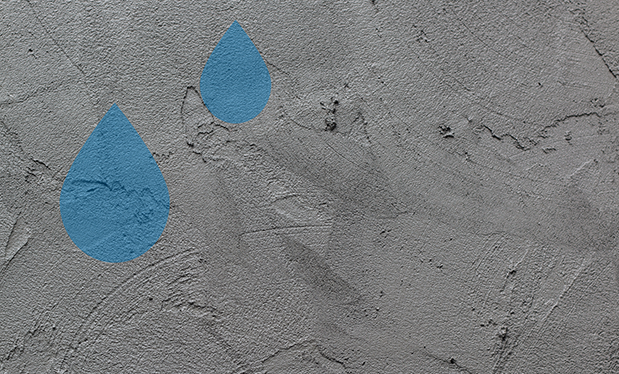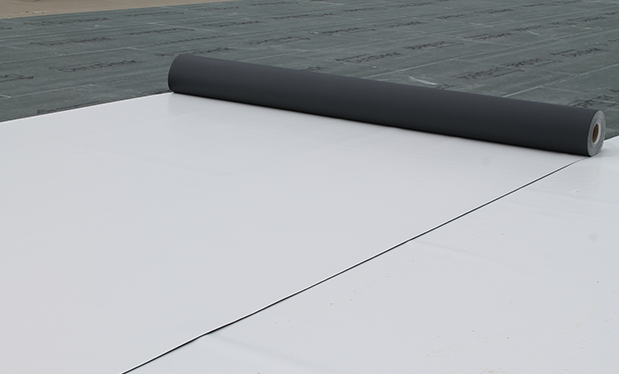During the past two decades, roofing project requirements have specified highly reflective roof covering materials. The requirements are included in model energy codes, codes and ordinances adopted or enacted by local jurisdictions, and building certification programs for construction projects. The list of codes and certification programs requiring highly reflective roof coverings has grown during the past two decades and includes:
- Municipal Code of Chicago
- Philadelphia Code
- New York City Building Code
- Municipal Code of the City of Los Angeles
- ASHRAE Standards 90.1 and 189.1
- International Energy Conservation Code (IECC), 2012 and 2015 editions
- California's Building Energy Efficiency Standards—Title 2
- LEED
- Green Globes for New Construction
Depending on jurisdiction and type of construction, the requirements are intended to drive reductions in building cooling energy use, reductions in urban heat island effects or both.
Background
The requirements reference solar reflectance and thermal emittance ratings provided by the ENERGY STAR® Roof Products Program and Cool Roof Rating Council (CRRC) Products Rating Program. Although ENERGY STAR predates the CRRC Products Rating Program, current ENERGY STAR requirements for roofing products primaily rely on CRRC-developed ratings. These ratings appear in roof covering manufacturers' marketing materials and product data sheets typically included by roofing contractors as part of submittals packages when bidding projects.
When the requirements first appeared, compliance could be substantiated on the basis of radiative property ratings reported for new materials or for materials exposed to three years of weathering. Although this remains true for some jurisdictions, most current codes, ordinances and standards provide requirements based on three-year-aged reflectance ratings.
For example, the prescriptive requirement introduced in June 2001 in the Municipal Code of Chicago called for minimum initial reflectance of 0.65 or minimum three-year-aged reflectance of 0.50 for low-slope roof surfaces. The current Chicago requirement calls for minimum initial reflectance of 0.72 or minimum three-year-aged reflectance of 0.50 for low-slope roof surfaces.
On the other hand, IECC 2012 calls for minimum initial reflectance of 0.70 or minimum three-year-aged reflectance of 0.55 in Climate Zones 1-3, but IECC 2015 only references the three-year-aged minimum reflectance requirement. Many current codes, ordinances and standards also specify minimum three-year-aged solar reflectance index (SRI) requirements as alternatives. A product's SRI is calculated based on aged reflectance and emittance values.
The shift away from the initial values happened as three-year-aged values became available. Three-year-aged ratings developed in accordance with CRRC S100, "Standard Test Methods for Determining Radiative Properties of Materials," (formerly the CRRC-1 Standard) have come to represent in-service performance of rated products. But there is an issue with this. Although CRRC's Rated Products Directory provides radiative property ratings for more than 2,800 products, there is limited publicly available data regarding long-term reflective performance of these products when installed as part of in-service roof systems. This is significant because three-year-aged CRRC ratings are based on measurements of products exposed under idealized conditions.
During the course of three recent research projects, the Midwest Roofing Contractors Association (MRCA) and NRCA collected reflectance measurements from roof coverings exposed on in-service low-slope roofs. Each time, the researchers found reflectance values for in-service roofs typically were lower than three-year-aged CRRC reflectance ratings for the same products.
CRRC program
Central to CRRC's purpose is administration of the CRRC Product Rating Program. CRRC S100 provides criteria for specimen preparation, weathering, testing and reporting for the CRRC-1 Product Rating Program. As an American National Standards Institute (ANSI) standard, CRRC S100 is subject to regular updates through the ANSI process that requires making the standard available for public review and addressing public review comments.
The CRRC-1 Product Rating Program Manual governs the administration of the CRRC Product Rating Program. It is separate from CRRC S100. The CRRC-1 Product Rating Program Manual is not subject to the ANSI review process. It is maintained by CRRC's board of directors. The manual provides detailed instructions for product specimen preparation, weathering and testing intended for testing laboratories and weathering test farms that are accredited to participate in the rating program. The CRRC S100 and CRRC-1 Product Rating Program Manual instructions for product weathering are similar but not entirely consistent.
CRRC S100 calls for specimens to be exposed in accordance with ASTM G7, "Standard Practice for Atmospheric Environmental Exposure Testing of Nonmetallic Materials," mounted on plywood backing and placed in outdoor exposure racks in such a way that there is no runoff from one panel to another. The standard states steep-slope roofing products are to be exposed at the minimum recommended slope; low-slope roofing products and products designated for low- and steep-slope applications are to be exposed at low slopes only. The corresponding language in the CRRC-1 Product Rating Program Manual also references ASTM G7. However, the manual states products designated for steep-slope applications only shall be exposed facing south at 45 degrees (12:12); all other products shall be exposed facing south at 5 degrees (about 1:12).
It is important to note the most common design slope used in North America for low-slope roof systems is 1/4:12. This is the minimum design slope prescribed in the International Building Code for new construction membrane roof systems except built-up coal tar membrane roof systems.
ASTM G7, Section 5—Test Sites, Location of Test Fixtures, and Exposure Orientation, states that unless otherwise specified, exposure racks shall be located in cleared areas over ground cover typical of the climatological area, for example, gravel in desert areas to control dust and low-cut grass in temperate areas. The same section notes that if test fixtures are placed over rooftops, concrete or asphalt, test specimens may be subjected to different environmental conditions that may affect test results. CRRC S100 and the CRRC-1 program manual do not specify ground cover type.
The manual and standard call for a minimum of three continuous years' exposure in an outdoor environment at three test farms located in climates that meet specific criteria; climates include:
- Hot and humid, such as Miami
- Cold and dry, such as Chicago
- Hot and dry, such as Phoenix
Three specimens are exposed at each location. After three years of exposure, the aged radiative properties are measured. The aged values reported in the Rated Products Directory are averages of the measurements from all test farm locations.
Reflectometers on roofs
Roofing contractors are well-positioned to conduct research on reflective performance of in-service roof surfaces. MRCA and NRCA enlisted their members to help with the research projects.
For the projects, reflectance measurements were obtained using a portable version of the same reflectometer used by CRRC-accredited test laboratories—a Devices & Services Co. Solar Spectrum Reflectometer Model SSR-ER Version 5 (D&S SSR), which is shown in Photo 1. Measurements were collected in accordance with ASTM C1549, "Standard Test Method for Determination of Solar Reflectance Near Ambient Temperature Using a Portable Solar Reflectometer," which specifically applies to the reflectometer used. ASTM C1549 is the most commonly used of the three standard test methods of reflectance measurement permitted for use in the CRRC-1 program.
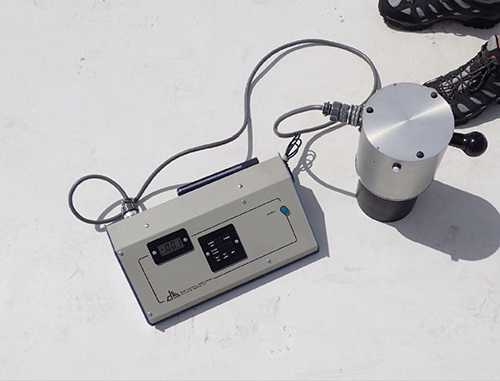
Photo 1: Devices & Services Co. Solar Spectrum Reflectometer Model SSR-ER Version 5 |
The relectometer is suitable for collecting readings from opaque, flat surfaces. To collect a reading in the field, the 1-inch-diameter port in the measurement head is placed flush with the surface to be measured. The built-in light source illuminates the sampled area for two seconds; the reflected light is picked up by detectors inside the head; and the measurement is calculated and displayed on the front panel of the control module. ASTM C1549 requires a minimum of three readings be obtained and averaged to evaluate a surface's reflectance. During the course of the first research project, researchers developed a protocol for sampling reflectances from 30 random locations per roof. The same protocol was used for subsequent research projects. All measurements were collected from roofs in an as-found condition. Roof surfaces were not cleaned as part of the measurement process.
Supplying the reflectometer with adequate power presented a challenge, at least for the first few years of the projects.
Researchers ran long extension cords to the point of measurement from wherever AC outlets could be accessed at or near the rooftop. Because ASTM C1549 requires a warm-up period and calibration each time the device is powered on, intermittent access to power stretched out the amount of time spent on a roof, particularly when having to move several times while collecting readings on large roofs. Later, a portable lead-acid battery pack was used and eventually the device was retrofitted to accept a slim lithium-ion battery.
ASTM C1549 requires readings be obtained from dry surfaces. Consequently, rain, standing water and morning dew constrain the opportunity for collecting reflectance readings from roofs. These considerations affected scheduling of rooftop work and caused delays in a number of instances.
Chicago study
Between March 2008 and September 2012, NRCA conducted a long-term reflectance monitoring study of in-service roof systems in the Chicago area. NRCA and Chicago Roofing Contractors Association (CRCA) member contractors assisted with securing access to roofs with ongoing installation work, recent roof system installations and existing roof systems.
Roof systems at various stages in their service lives were monitored, including new, months-old and more than 20-year-old examples. Because of weather, contractor availability and site access constraints, it was not practical to adhere to a firm schedule for measurements. Reflectance readings were collected about every year for 70 roof systems of various types. Forty-two of the roof systems were highly reflective single-ply membranes, polymer-modified bitumen membranes or membranes coated with white reflective acrylic coatings. With a few exceptions, ENERGY STAR- or CRRC-developed three-year-aged reflectance ratings were available for these roof systems.
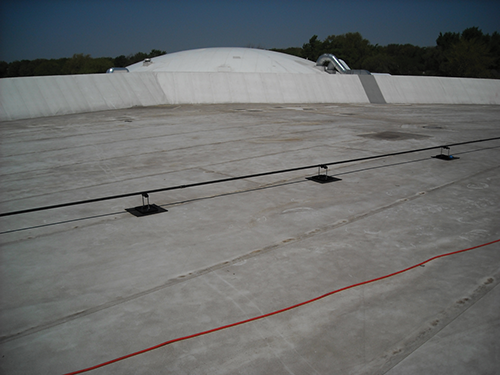
Photo 2: Steep-slope, barrel and dome cross-section roof surfaces visible in the background maintained higher reflectance values as compared with typically sloped roof surfaces in the foreground. |
The study found roof slope and drainage design, intense or above-average rainfall, rooftop foot traffic, roof location and facing direction, and building use are among variables that influence reflective performance of in-service roof surfaces.
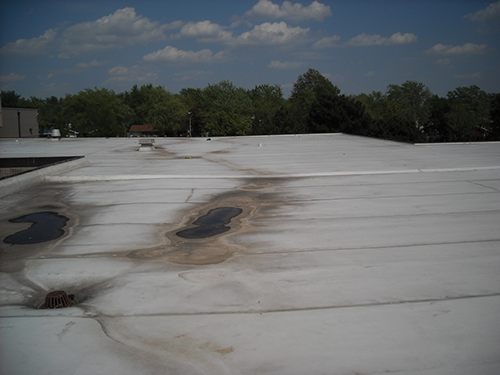
Photo 3: Poorly draining areas at the base of saddles with a typical design slope |
Effective drainage measurably improved retention of roof reflectance. Increased slope was found to be most effective at improving drainage and moderating or arresting reflectance decreases over time. Reflective roof membranes installed on steep-slope surfaces and barrel and dome cross-section roofs, similar to the ones visible in the background of Photo 2, maintained reflectance values at or above their CRRC-rated values. Photo 2's foreground shows reflectance was visibly less for the same membrane installed at a 1/4:12 slope at the same location. At this slope, it was common to find poorly draining areas marked by dirt and debris, such as saddles in Photo 3 and discolored membrane in Photo 4.
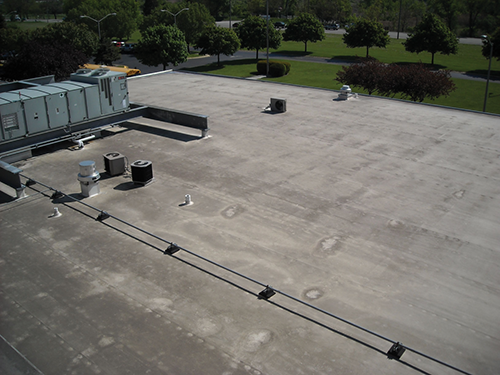
Photo 4: Discolored white single-ply membrane |
Additionally, intense rainfall and above-average rainfall rates had a cleansing effect on a number of roofs in the study. In 2011, after a particularly wet spring and summer, reflectance increases were recorded for at least 15 roofs monitored in the project.
Mod bit in Texas
MRCA's Technical and Research Committee commissioned a study in spring 2012 where reflectance measurements were collected from highly reflective polymer-modified bitumen membranes installed in the Dallas and Austin, Texas, areas. NRCA provided equipment and staff support for the research.
Reflective cap sheet products from seven manufacturers installed on 28 roofs were included in the study. The roofs were between 3 months and nearly 6 years in age. Several types of cap sheet surfacings were represented, including mineral granules, mineral granules with a factory coating, acrylic chips, factory-applied coating and laminated reflective film.
For each roof, at least 30 reflectance readings were collected from randomly selected locations. This sample size was significant because it allowed researchers to estimate the actual average reflectance with a high degree of confidence.
Three-year-aged CRRC reflectance ratings were available for cap sheets installed on 20 of the roofs. A comparison of the average measured reflectances and corresponding CRRC-rated reflectance ratings prompted the following conclusions:
- In-service reflectances measured for 12 out of 20 cap sheets were below their three-year-aged CRRC ratings.
- For the products that fell short of their ratings, many were much younger than 3 years of age.
- Significant differences among in-service reflectances for the same product installed at two or more different locations suggest service conditions influence reflective performance.
Single-ply membranes
The third research project took place in fall 2015. This study was different from the earlier efforts in that measurements were collected from roof systems located in three geographic locations specifically identified in the CRRC-1 rating program manual and CRRC S100 standard as suitable for test farm locations, namely Chicago, Miami and Phoenix. Also, the research specifically focused on reflective single-ply roof membranes.
Participating contractors were asked to secure access to highly reflective single-ply roof systems. The decision to focus on reflective single-ply membranes was dictated by limited time and resources and the fact that it is the go-to roof system category for commercial building owners when roofing projects are required to comply with reflectance requirements. Figure 1 provides the inventory of roof systems, and it is evident different single-ply membranes were not uniformly represented in the three areas. For example, white EPDM roof membranes only were available for inspection in the Chicago area. The researchers considered this inventory to be composed of random samples of the local reflective single-ply roof membrane populations.
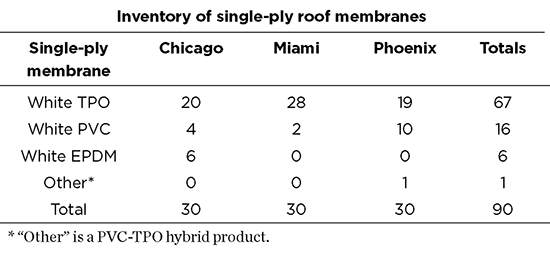
Figure 1: Single-ply membranes studied |
In-service roof systems in the research locations provide reflectance data suitable for a direct comparison with three-year-aged CRRC reflectance ratings. Ideally, all the roof systems would be about 3 years old, but for practical reasons, roof systems aged between a few weeks and 15 years were included. Figure 2 shows the age distribution of all roof systems in the study.
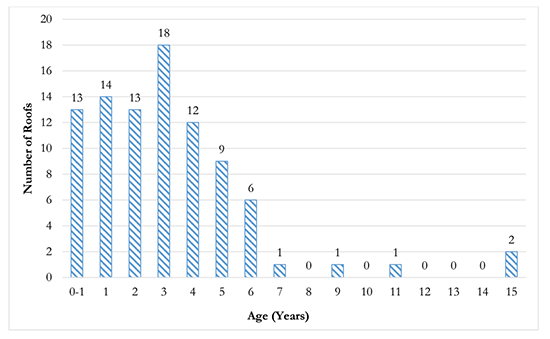
Figure 2: Age distribution of roof systems in the single-ply study |
Each roof system's reflectance was calculated as the arithmetic average of 30 measurements from random locations on the membrane surface except for vertical surfaces such as parapet walls and equipment curbs. Typically, for aged reflective single-ply roof membranes, a stark contrast is observed between reflectances of the roof membrane and flashing membrane above a roof-to-wall transition or membrane above a steep-slope transition as shown in Photo 2.
In Figure 3, reflectances for all 90 roofs are plotted against their reported ages. The plot indicates the existing reflective single-ply roof systems maintain their reflectances well. The global average for all roof systems in the study was 0.636.
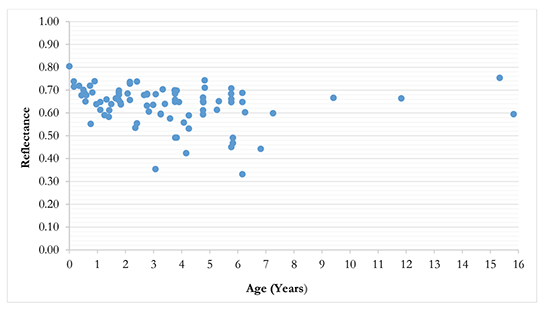
Figure 3: In-service aged reflectance vs. roof system age for the single-ply study |
Subtracting three-year-aged CRRC rating values from the aged reflectances in Figure 3 produces the plot in Figure 4 that illustrates how much the ratings differ from in-service reflectances. Positive values represent roof systems where ratings underestimate performance; negative values represent roof systems where ratings overestimate performance. Figure 4 shows values for 89 roof systems. Three-year-aged CRRC reflectance ratings were available for all but one single-ply sheet in this study.
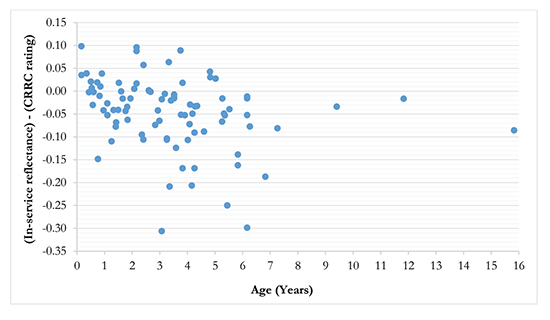
Figure 4: Difference between in-service reflectance and three-year-aged CRRC rating vs. roof system age for the single-ply study |
Figure 4 also indicates three-year-aged CRRC ratings do not accurately predict in-service performance—the values would be clustered around 0 for aged systems if the opposite were true. To further explore this question, raw data were used to construct statistical confidence intervals at a 95 percent confidence level around the mean reflectance values. None of the confidence intervals contained the corresponding CRRC rating value. Simply stated, this indicates if the same study were conducted 100 times, in 95 instances it would arrive at the same conclusion.
The results shown in Figure 4 were sorted by sheet type and geographic area. Then, averages were separately calculated for each sheet type within each geographic area and overall by type and area to look for clues to how different single plies performed and how environmental conditions in Chicago, Miami and Phoenix affect different products. Those numbers are shown in Figure 5.

Figure 5: Comparison of in-service research vs. three-year-aged CRRC ratings |
As with Figure 4, positive values indicate better-than-expected performance; negative values indicate performance that fell below expectations. Some interesting information may be gleaned from the results. One item of note in Figure 5 is the significant difference between TPO and PVC membranes in Phoenix. The researchers observed many PVC membranes became discolored by desert dust but TPO membranes were not similarly affected. Also, white EPDM performance was encouraging though these membranes only were available in Chicago and had been in service a relatively short time.
As noted in the earlier studies, site-specific conditions affected the results and no two roofs should be expected to perform the same way because of countless interactions among variables that contribute to in-service reflective performance. Based on observations recorded in Chicago, Miami and Phoenix, the researchers identified contributing conditions that included climate type, roof slope, drainage patterns, predominant wind currents, building aerodynamics, building occupancy, local pollutants, biological growth, place of manufacture, amount of roof insulation, rooftop air handling and unit exhaust configuration, surrounding vegetation and dust storms.
It is impractical to reproduce site-specific variability when aging product specimens at a test farm. Therefore, it is not reasonable to rely on test-farm-developed reflectance ratings for predicting in-service reflective performance. The researchers proposed an alternative approach when predicting reflective performance of in-service roof membranes for design and computer modeling purposes. The approach borrows from the Allowable Stress Design (ASD) method used in civil engineering. With ASD, engineers accept they cannot possibly anticipate all the stresses a structural member may experience in service and instead design for maximum stresses that remain under a certain lower limit established by using a reduction factor.
A similar approach for in-service roof membrane reflectance has the rated values reduced by a certain factor to obtain a more conservative—and realistic—estimate of actual performance. Appropriate factors, depending on expected roof membrane soiling level, were determined from analyzing values shown in Figure 4.
Recommendations
The research resulted in several recommendations.
First, three-year-aged CRRC reflectance ratings are useful for product comparisons; however, the ratings do not accurately represent in-service reflective performance of roof surfaces and should not be relied on for design or computer modeling purposes. Decisions about rooftop temperatures and sizing of building mechanical equipment should not be based on the ratings.
Second, reflective roof membranes in low-slope applications should be expected to retain aged in-service reflectance values that are less than their three-year-aged CRRC reflectance ratings. As a result, membranes should be expected to experience higher in-service temperatures than would be expected with the current ratings.
And third, with respect to the findings of the 2015 single-ply roof membrane project, the researchers recommend when using three-year-aged CRRC reflectance ratings of reflective single-ply roofing sheets in sizing heating, ventilating and air-conditioning equipment and computer modeling of building performance, designers should adjust the values by -0.10 for normal soiling level scenarios and -0.15 for heavy soiling level scenarios. Normal soiling level scenarios include residential and commercial buildings where use and the surrounding environment do not generate significant roof membrane soiling. Heavy soiling level scenarios include buildings where industrial use and the surrounding environment subject the roof membrane to increased soiling.
Maciek Rupar is an NRCA director of technical services.

